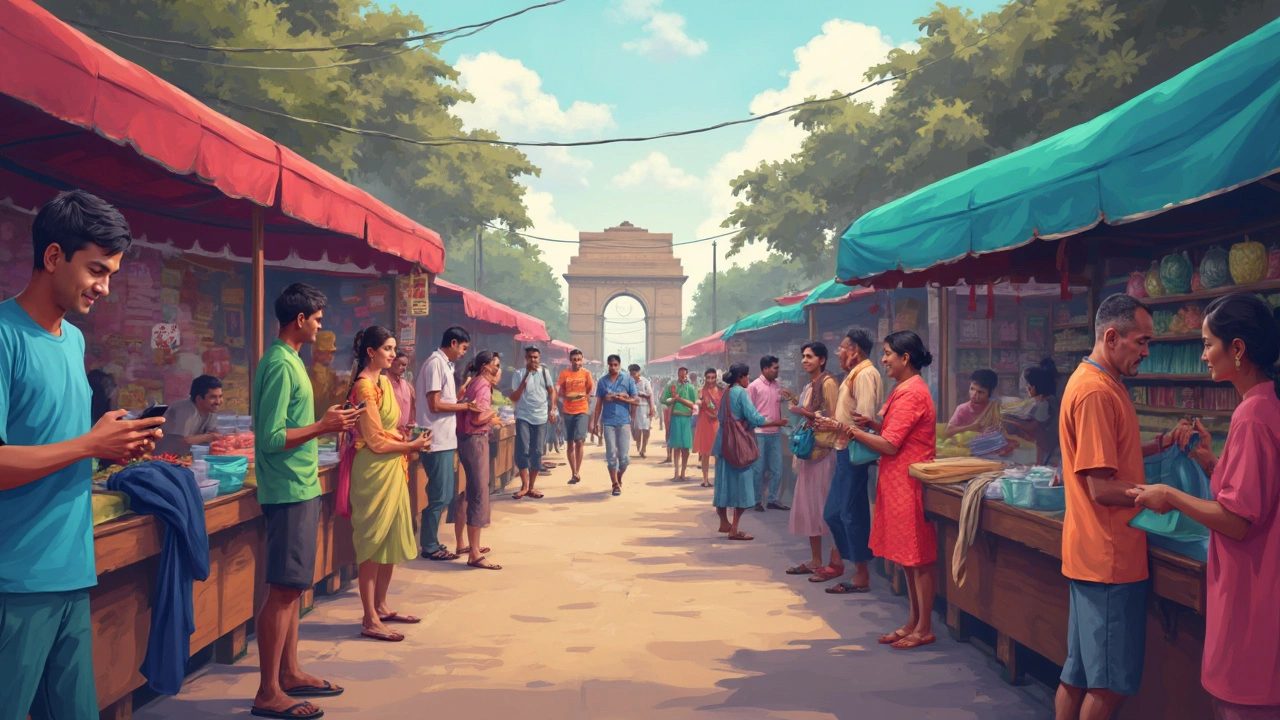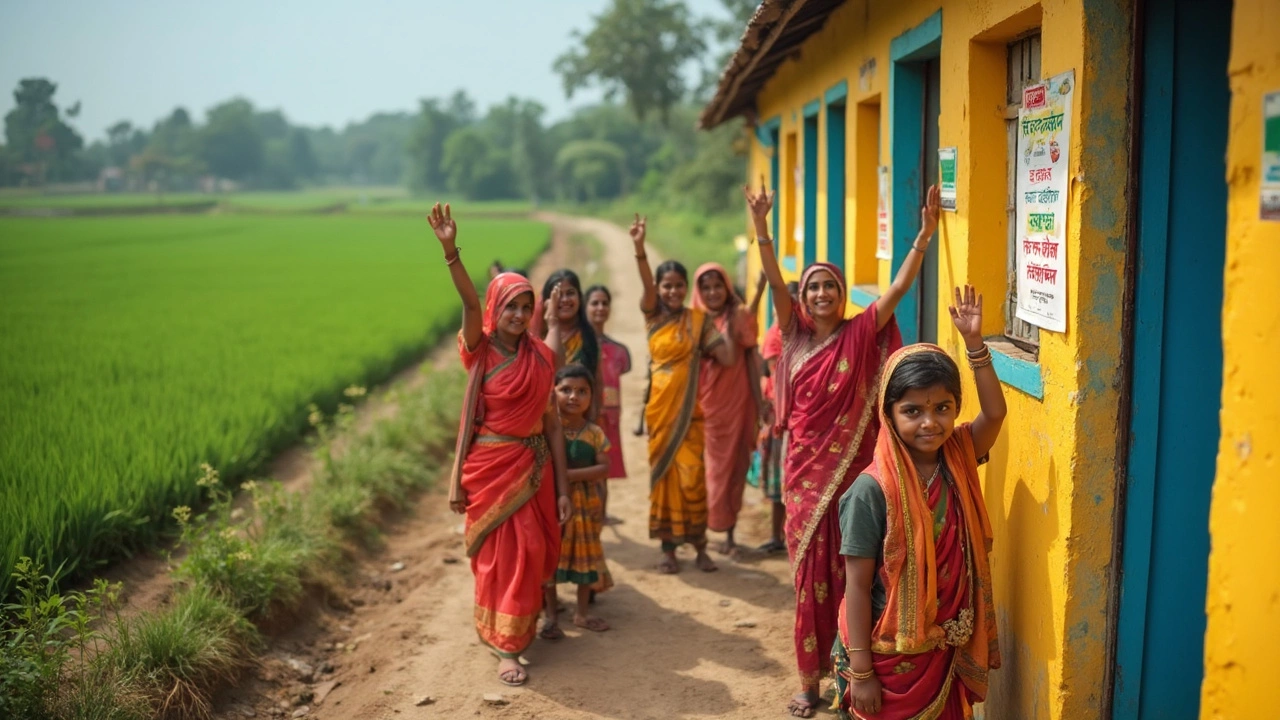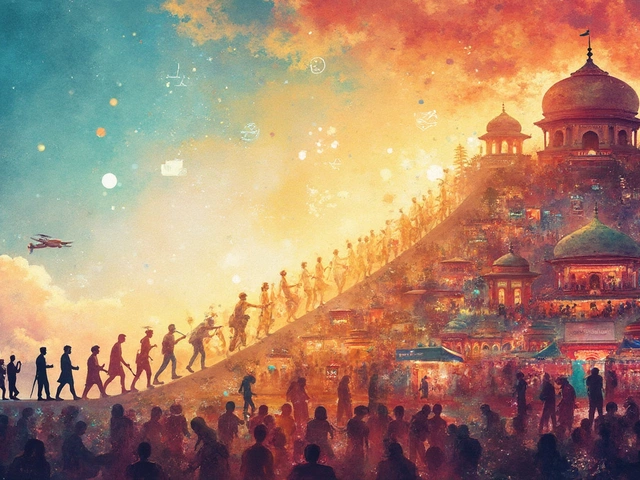People have opinions about Narendra Modi, but opinions don’t always pay your bills or get your sick grandma a bed in a hospital. What sticks are the things you feel in day-to-day life—the schemes, the policies, the money in (or out of) your pocket. Modi’s government rolled out some of the largest public programs ever seen, changed how people bank, cook, build, and sometimes, how they argue with their neighbors. Did it fix everything? Far from it. But ignoring what actually changed helps nobody.
Take Pradhan Mantri Awas Yojana, for example. Suddenly, millions of families had concrete roofs. Or remember the chaos and debates during demonetization? That was 2016—wallets emptied overnight, but digital wallets got a turbo boost. And who can miss the Swachh Bharat Mission? Building toilets became the talk of every small village. Pretty wild to think toilets were news, right? These things reach from cities buzzing with startups to tiny hamlets where people care mostly about clean water and a road that doesn’t disappear in the rain.
- Big-ticket Government Schemes
- How Modi Changed Everyday Life
- Economic Moves That Made Noise
- Spotlight: Health, Sanitation, and Welfare
- Lasting Changes or Just Buzz?
Big-ticket Government Schemes
If you ask anyone which Narendra Modi scheme sticks out, odds are they name something huge—like Swachh Bharat or Jan Dhan. These government moves weren’t just updates to old plans. They aimed to shake up daily routines for millions. Let’s break down a few that actually touched lives everywhere.
- Pradhan Mantri Jan Dhan Yojana (PMJDY): Launched in 2014, this was all about getting almost every Indian a bank account. By 2024, over 50 crore accounts were opened, many by folks who never had one before. Rural moms, street vendors, farmhands—suddenly, a phone beeping with a digital money transfer was normal, not sci-fi.
- Swachh Bharat Mission: Modi got people talking about toilets—seriously. The numbers jump out: by 2019, the mission claimed over 100 million toilets built across the country. Villages where open defecation was just ‘how it’s done’ saw actual bathrooms pop up in schools and homes. Kids, especially girls, benefited most, getting safer school experiences.
- Pradhan Mantri Awas Yojana: Imagine over three crore houses being built since 2015, aimed at the folks who always wondered if ‘own home’ was pipe dream talk. If you’ve seen small, sturdy homes with LPG stoves and a name painted on the wall, chances are this scheme was behind it.
- Ujjwala Yojana: Cooking with wood and cow dung is still common, with lung disease tagging along. Ujjwala handed out more than nine crore free LPG connections to women below poverty line. Visiting family in a village? Watch for new gas stoves—often, they’re thanks to this policy.
- Ayushman Bharat: Think of it as health cards with hospital insurance—up to ₹5 lakh per year, covering serious illnesses. By 2023, over 5 crore people had received hospital treatments without paying out-of-pocket, many for the first time ever. Ambulance staff in rural Jharkhand swore these golden cards often made the difference between life and death.
Here’s a quick look at some headline stats:
| Schemes | Launch Year | Key Achievements |
|---|---|---|
| Jan Dhan Yojana | 2014 | 50+ crore bank accounts |
| Swachh Bharat Mission | 2014 | 100+ million toilets built |
| Ujjwala Yojana | 2016 | 9+ crore LPG connections |
| Awas Yojana | 2015 | 3+ crore houses built |
| Ayushman Bharat | 2018 | 5+ crore treatments |
If you’re living outside India, these numbers are mind-boggling. But if you’ve watched your grandma chuck her firewood stove or your cousin finally open a bank account with her thumb, these stats are the reason why Modi’s government schemes get talked about—positively or not—everywhere.
How Modi Changed Everyday Life
If you ask folks in small towns or big cities what’s different under Narendra Modi, most will point to everyday stuff: bank accounts, gas cylinders, toilets, or even their phone. These things sound basic, but life before these schemes felt like a series of waitlists and middlemen. Now, you can actually see the difference at home and on the street.
Let’s start with government schemes everyone talks about:
- Jan Dhan Yojana: Opened over 500 million bank accounts in just a few years. People who never stepped into a bank now get subsidies straight to their accounts—no more losing out to local touts skimming off the top.
- Ujjwala Yojana: Suddenly, having an LPG gas cylinder in the kitchen was not just a thing for city slickers. Over 100 million families now cook without shady kerosene or firewood, which means fewer smoky kitchens and better health for kids and women.
- Swachh Bharat: This one changed morning routines the most—villages that never had toilets now have millions built across the country. It actually became embarrassing not to have a toilet, and people talk about hygiene way differently now.
Tech isn’t just for the young city crowd anymore. Digital payments and UPI took over after that demonetization drama. Local sabziwalas (vegetable sellers) and auto drivers now carry QR codes. Giving or receiving money is as simple as a tap, anytime, anywhere.
| Scheme | Homes/People Impacted (Approx.) |
|---|---|
| Jan Dhan Yojana | 500 million+ |
| Ujjwala Yojana | 100 million families |
| Toilets Built under Swachh Bharat | 110 million+ |
| Pradhan Mantri Awas Yojana (Houses) | 25 million houses |
The reach of these Indian policies became most obvious during COVID-19. If you suddenly got your ration or cash help from the government in 2020, it was because those bank accounts and digital transfers were already running. Old paper systems would’ve just collapsed.
Even for stuff like passports, pensions, or getting tractors, getting things done is more online and less about waiting in long, sweaty lines. Life’s not perfect, but there’s less juggling between different babu (clerk) counters. That’s a change nobody’s really missing.

Economic Moves That Made Noise
Whenever someone talks about Narendra Modi, the first headline that pops up is usually about demonetization. In November 2016, the government announced that ₹500 and ₹1,000 notes were no longer valid. It was massive—millions queued outside banks, and there was a scramble for cash. The move aimed to target black money, fake notes, and nudge people into digital payments. Whether you were a street vendor or a shop owner, this change made you think twice about how you used cash. The aftershock? UPI and digital wallets shot up in popularity. According to the National Payments Corporation of India, UPI transactions moved from just over 15 million in 2016 to more than 8 billion per month by early 2025.
Another big push was the Goods and Services Tax (GST) launch in 2017. Instead of a messy web of state and central taxes, now there was one tax for almost everything you bought. Small businesses felt the growing pains, but GST simplified a lot of paperwork in the long run, especially for those who sell across different states. Even kirana shop owners talk about GST now, and you don’t have to be a tax expert to see the difference on your bills.
- The Make in India campaign tried to get international and local companies to build stuff in India instead of just importing it. Some sectors like electronics and mobile phones actually saw more factories open up. Apple, for example, started assembling iPhones in India during Modi’s term.
- Startup India gave a boost to people with ideas but no money or rich uncles. Thousands of startups got registered, and it became easier to get funding and paperwork sorted out.
- Jan Dhan Yojana made it possible for even the simplest accounts to be opened at banks, helping crores of Indians enter the formal banking system for the first time. By 2024, more than 50 crore (500 million) new bank accounts had been created under this plan.
Numbers tell the real story. Check out this table showing UPI growth and GST collections over the years:
| Year | UPI Transactions (per month) | GST Collection (Rs crore, monthly avg.) |
|---|---|---|
| 2017 | 20 million | 90,000 |
| 2020 | 1 billion | 1,00,000 |
| 2024 | 8 billion | 1,45,000 |
So yeah, some moves hurt for a while and businesses had to adapt, but these decisions shook up how the Indian economy worked. Love them or hate them, they forced people to think differently about money, taxes, and running a business.
Spotlight: Health, Sanitation, and Welfare
Let’s cut to the chase—this is where Narendra Modi put a lot of focus, starting with the Swachh Bharat Mission (Clean India). Before 2014, millions of Indians still didn’t have a toilet at home. The government said it built over 110 million toilets across the country by 2019. Dirty streets and open defecation have dropped in many areas. Some parts still struggle, but you can’t ignore how restroom talk went mainstream, which is rare anywhere, not just in India.
When COVID-19 hit, Modi’s push for building toilets, clean water, and better hygiene paid off. But there’s more—Ayushman Bharat, the world’s largest government-funded healthcare scheme, started in 2018. It promises up to ₹5 lakh coverage per year per family for nearly 50 crore (500 million) people. Real people, not just headlines, got free surgeries and medicines.
Modi’s team also rolled out the Ujjwala Yojana, making cooking gas available to poor households. Before, many families burned wood or cow dung for cooking, filling kitchens with smoke. Now, over 9 crore (90 million) women have new LPG connections, and that means less time collecting firewood, fewer breathing problems, and cleaner air at home.
- Swachh Bharat Mission: Over 110 million toilets built, serious push against open defecation.
- Ayushman Bharat: Up to ₹5 lakh medical cover per family, 50 crore people touched by free or subsidized healthcare.
- Ujjwala Yojana: More than 9 crore women got free LPG connections. Cleaner kitchens, healthier lives.
Here’s a quick look at how these schemes stacked up in numbers:
| Scheme | Launch Year | People Covered (millions) |
|---|---|---|
| Swachh Bharat Mission | 2014 | 600+ |
| Ayushman Bharat | 2018 | 500 |
| Ujjwala Yojana | 2016 | 90 |
Sure, there are still plenty of gaps. Not everyone got the benefits, and some areas need way better follow-through. But these government schemes and Modi achievements made a dent in old problems—sometimes literally saving lives, sometimes just making daily life less of a struggle.

Lasting Changes or Just Buzz?
When you hear about Narendra Modi and his big government schemes, you probably wonder what actually sticks around after the banners come down. Are these moves real game-changers or just things that look good on TV? Let’s cut through the noise with actual examples and facts.
First, there’s no denying that some schemes made permanent marks. Take Swachh Bharat—India’s sanitation coverage shot from about 39% in 2014 to over 95% by 2019, according to official numbers. Kids in rural schools, for instance, have far better access to toilets now compared to a decade ago. Villages smell less, diseases spread less. That’s not just buzz—it’s a different life altogether for millions.
Now move to Jan Dhan Yojana. Before Modi, opening a bank account was a headache, especially if you lived way out in a village. By 2023, over 490 million accounts had been opened, a massive boost for financial inclusion. Suddenly, people got direct transfers for LPG, rations, and even COVID support—no bribes, no middlemen. That’s real change in how money moves in India.
That said, not everything stuck the landing. Remember the demonetization buzz in 2016? The purpose was to curb black money and push digital payments. Digital payments are everywhere now—tea stalls, farmers, even your neighborhood fruit guy uses UPI. But did demonetization wipe out black money? Not really. The Reserve Bank of India later reported that over 99% of scrapped notes found their way back into the system. So, some buzz, but not quite the impact promised.
If you want a clear view, look at the basics—water, food, jobs. Modi’s PM Garib Kalyan Anna Yojana fed about 800 million people free grain during COVID lockdowns. That literally meant survival when jobs vanished overnight. But when it comes to jobs and small business health, the reality isn’t all roses. Unemployment is still a sore spot, and report after report says small businesses got battered, especially during the pandemic.
Here’s a quick look at how some major Modi-era schemes fared:
| Scheme | Launched | Reach/Achievement | Criticism/Limit |
|---|---|---|---|
| Swachh Bharat | 2014 | 100+ million toilets built | Questions on long-term use/maintenance |
| Jan Dhan Yojana | 2014 | 490+ million bank accounts | Dormant accounts, limited use |
| Demonetization | 2016 | Digital payments growth | Minimal impact on black money |
| PM Garib Kalyan Anna Yojana | 2020 | 800 million received food aid | Temporary measure, doesn’t solve poverty |
People on the ground see both sides. If you’re from a small town or village, you’ve likely used at least one government scheme. But some of these programs come with paperwork, delays, or fall short in the end. Big change takes time. India’s size and diversity mean nothing works everywhere equally. Still, more folks have bank accounts, access to food rations, and toilets than ever before.
The bottom line? Some buzz fizzled, but lots of things stuck—and they shape daily life in a way that’s hard to ignore, whatever your politics. Next time you tap your phone for UPI or see a clean toilet in a remote school, you’re looking at Modi’s legacy, for better or worse.


